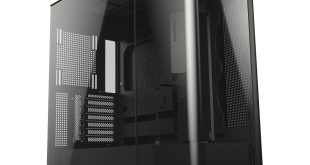To test the Silverstone Sugo SG07 with Zotac H55 ITX Wifi motherboard we are using a set of relatively high end comparison products. To quickly recap we are using a Core i5 655k processor (review here) which is a Core i5 processor with hyperthreading, this runs at 3.2ghz. We have it cooled by a Thermaltake Slim X3 Low Profile cooler and we are using Noctua NT H1 high quality thermal paste. We are using 8GB of Hyper X DDR31600mhz by Kingston (review here). The graphics power is handled by the excellent HIS HD5870 iCooler V Turbo (reviewed here).
We set the 1800 Silverstone Penetrator Fan to low speeds for this testing as we don't think high is a realistic long term setting, it is noticeable and defeats the purpose of such a great media centre chassis. Room ambient temperatures were kept at a steady 25c via air conditioning in our test labs. Idle readings are measuring after 30 minutes of testing in the desktop after a fresh boot. We achieved our load results by looping Cinebench R11.5 with Furmark for 20 minutes then taking the highest result throughout this time period.
Thanks to the 180mm Penetrator fan these temperatures are as good as we would expect to see in a full size chassis and we were extremely satisfied with these results.
We next wanted to see if we could crank the overclock on the Core i5 655k – while we wont get anywhere near the 5ghz we achieved with the Noctua NH D14 in the past, we hope that 4ghz is a sweet spot we can achieve. We therefore increased the voltage by 0.1 in the bios and raised the unlocked multipler.
We managed to hit 4.05ghz with voltage around 1.32 but while idle temperatures looked fine, we wanted to retest under load. We should also note that the Zotac motherboard has a ‘clear CMOS' button which is accessible from the back without having to open the chassis. We had to use it quite a bit during our overclocking testing so this was a godsend.
This was a pleasant surprise for us as we managed to break the 4ghz mark without hitting 70c on either 655k core. While we could raise the voltage higher and possibly push the CPU to 4.2ghz we like to keep our temperatures well within check and what we have achieved would be a perfectly usable 24/7 set of parameters. The SG07 is clearly a small form factor case with strong overclocking potential because when we overclock our processor the ambient temperatures only fluctuate slightly.
Recently we have changed our method of measuring noise levels. We have built a system inside a Lian Li chassis with no case fans and have used a fanless cooler on our CPU. We are using a heatpipe based passive power supply and an Intel SSD to keep noise levels to a minimum. The motherboard is passively cooled and we use a Sapphire HD5670 Ultimate Edition graphics card which is also passively cooled. Ambient noise in the room is kept as low as possible. We measure from a distance of around 1 meter from the chassis and 4 foot from the ground to mirror a real world situation.
Why do this? Well this means we can eliminate secondary noise pollution in the test room and concentrate on only the components we are testing. It also brings us slightly closer to industry standards, such as DIN 45635.
To test today we are using the Silverstone SG07 chassis with the supplied 600W PSU and 180mm Penetrator fan, we have however removed the fan from the 655k heatsink and have replaced the HIS HD5870 with a Sapphire HD5670 Ultimate Edition – this ensures we are only recording the noise from the Silverstone SG07 as it is supplied out of the box. The room rates as 21dBa – the air conditioning unit in the far corner of the room causes this. We use a Digital Sound Level Noise Decibel Meter Style 2.
KitGuru noise guide
10dBA – Normal Breathing/Rustling Leaves
20-25dBA – Whisper
30dBA – High Quality Computer fan
40dBA – A Bubbling Brook, or a Refridgerator
50dBA – Normal Conversation
60dBA – Laughter
70dBA – Vacuum Cleaner or Hairdryer
80dBA – City Traffic or a Garbage Disposal
90dBA – Motorcycle or Lawnmower
100dBA – MP3 player at maximum output
110dBA – Orchestra
120dBA – Front row rock concert/Jet Engine
130dBA – Threshold of Pain
140dBA – Military Jet takeoff/Gunshot (close range)
160dBA – Instant Perforation of eardrum
With the 180mm fan on low we noticed that the PSU is adding a tiny amount of extra noise to the Penetrator fan noise output, but when on high the top mounted fan is overpowering any noise the PSU is making. On low settings the system is almost silent, but on high its clearly audible, there is no half way ground here. What would we use? Low all the time because high settings are slightly intrusive.
 KitGuru KitGuru.net – Tech News | Hardware News | Hardware Reviews | IOS | Mobile | Gaming | Graphics Cards
KitGuru KitGuru.net – Tech News | Hardware News | Hardware Reviews | IOS | Mobile | Gaming | Graphics Cards





